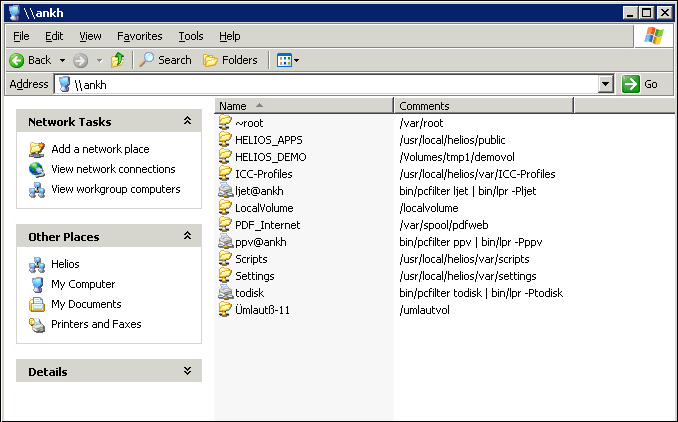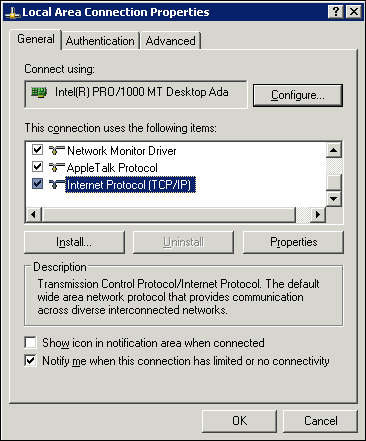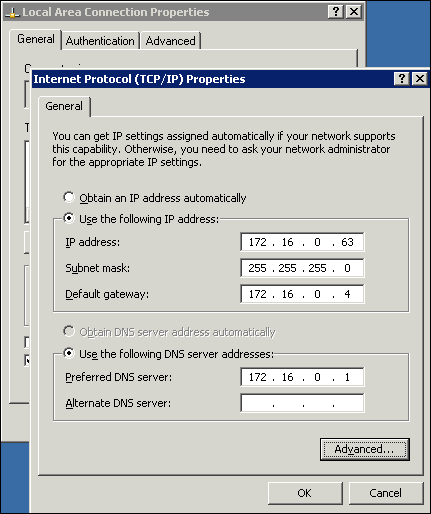PCShare UB+ User manual |
||||
A 1 Connecting Windows clients to the PCShare server
If you should encounter any problems while trying to connect to a PCShare server, you should verify the setup. In the following we give some proposals for checking, step by step, that the software installation was successful and the connection is working.
Note: In a complex network you may have to wait several minutes after starting PCShare before a stable browsing hierarchy has been reached. You may not see the workgroup/domain in the Windows My Network Places list.
Please look always into the system messages for PCShare related error/warning messages if a problem occurs.A 1.1 IP configuration and Windows
The following tips may be helpful if a Windows client cannot see the PCShare server:
Verify the Windows TCP/IP configuration by use of the "ping" utility, e.g. via the Windows command prompt:
ping <PCShare server name>C:\WINDOWS>ping druagaIf the PCShare server is available by name "ping" returns the following protocol on screen:
Pinging druaga [172.16.0.63] with 32 bytes of data:Reply from 172.16.0.63: bytes=32 time<1ms TTL=64Reply from 172.16.0.63: bytes=32 time<1ms TTL=64Reply from 172.16.0.63: bytes=32 time<1ms TTL=64Reply from 172.16.0.63: bytes=32 time<1ms TTL=64Ping statistics for 172.16.0.63:Packets: Sent = 4, Received = 4, Lost = 0 (0% loss),Approximate round trip times in milli-seconds:Minimum = 0ms, Maximum = 0ms, Average = 0msIf the requested server (in this example "druaga") is known to the network but, for any reason, not up and running the protocol returns the following message:
Pinging druaga [172.16.0.63] with 32 bytes of data:Request timed out.Request timed out.Request timed out.Request timed out.Ping statistics for 172.16.0.63:Packets: Sent = 4, Received = 0, Lost = 4 (100% loss),Approximate round trip times in milli-seconds:Minimum = 0ms, Maximum = 0ms, Average = 0msIf the PCShare server name is not detected on the network "ping" returns Unknown host <PCShare server name>. In this case you should run "ping" again trying the server IP address instead:
C:\WINDOWS\ping 172.16.0.63Pinging 172.16.0.63 with 32 bytes of data:Reply from 172.16.0.63: bytes=32 time<1ms TTL=64Reply from 172.16.0.63: bytes=32 time<1ms TTL=64Reply from 172.16.0.63: bytes=32 time<1ms TTL=64Reply from 172.16.0.63: bytes=32 time<1ms TTL=64Ping statistics for 172.16.0.63:Packets: Sent = 4, Received = 4, Lost = 0 (0% loss),Approximate round trip times in milli-seconds:Minimum = 0ms, Maximum = 0ms, Average = 0msNote: If the client PC is running any firewall software, this software must be configured to allow access between server and client. Refer to the instructions of the firewall software.If the connection has been successfully established, check if your user name is known to the PCShare server (e.g. in the User tab in HELIOS Admin, see also the chapter "HELIOS Admin" in the Base manual).
Note: The user name for the Windows network login must match the user name and password on the server. Otherwise Windows will return a "Network Error".
Under Windows 95/98/Me, you can only mount server volumes from the Network Neighborhood dialog using one unique user name on client and PCShare server. Under Windows NT/2000/XP/2003/Vista, you can mount server resources under different user names.You can also try to find the server in question with the Windows search engine:
Click the Start button and then select Search > Other search options > Computers or people.
Type the name of the server in the Computer name field and click Search (Fig. A-1).

Another option is to use the server IP address instead of the name in the Computer name field.
In Windows Explorer enter the server name or the IP address (Fig. A-2):
\\<server name> or \\<ipaddress> or \\<WINS name>

A 1.1.1 Displaying the client's TCP/IP settings
To check the Windows client's TCP/IP configuration settings there are two ways to obtain all the values at a glance:
Under Windows 95/98/Me use "WinIPCfg":
To open "WinIPCfg", click Start > Run and enter winipcfg in the Run dialog box.
The window IP Configuration appears (Fig. A-3) displaying the settings of the (physical) Ethernet Adapter Address, the IP Address, the Subnet Mask, and the Default Gateway.
You may want to check more TCP/IP settings, e.g. about installed DHCP, DNS, and WINS server(s). To obtain this extended information do the following:
Click on the More Info >> button to get more detailed and comprehensive information from the IP Configuration window.
Under Windows NT4/2000/2003/XP/Vista enter the following command:
ipconfig /allThe output should look similar to this:
Windows IP ConfigurationHost Name . . . . . . . . . . . . : chromaPrimary Dns Suffix . . . . . . . :Node Type . . . . . . . . . . . . : HybridIP Routing Enabled. . . . . . . . : NoWINS Proxy Enabled. . . . . . . . : NoDNS Suffix Search List. . . . . . : dyn.helios.deEthernet adapter Local Area Connection:Connection-specific DNS Suffix . : dyn.helios.deDescription . . . . . . . . . . . : Intel(R) PRO/1000 MT Desktop AdapterPhysical Address. . . . . . . . . : 00-10-DC-CB-68-E7DHCP Enabled. . . . . . . . . . . : YesAutoconfiguration Enabled . . . . : YesIP Address. . . . . . . . . . . . : 172.16.3.88Subnet Mask . . . . . . . . . . . : 255.255.252.0Default Gateway . . . . . . . . . : 172.16.0.3DHCP Server . . . . . . . . . . . : 172.16.0.1DNS Servers . . . . . . . . . . . : 172.16.0.1Primary WINS Server . . . . . . . : 172.16.0.1Lease Obtained. . . . . . . . . . : Monday, 23. May 2005 08:59:42Lease Expires . . . . . . . . . . : Tuesday, 24. May 2005 00:59:42A 1.1.2 The "Network" Control Panel
The configuration of your client's network connection is done in the Network Control Panel, where you can specify among other things DNS, WINS, and IP address settings. This can be done statically or dynamically (DHCP).
Open Start > Control Panel > Network Connections. Select Local Area Connection. In the status window click Properties.

In the configuration window (Fig. A-4) double-click the entry Internet Protocol (TCP/IP) network component.
The Internet Protocol (TCP/IP) dialog appears, allowing you to configure IP address, Gateway, DNS, NetBIOS, and WINS.
Before you specify an IP address for your Windows client you have to know whether the IP address is to be assigned manually (i.e. you specify it once in the Internet Protocol (TCP/IP) dialog) or dynamically (via DHCP server).
In the Internet Protocol (TCP/IP) window (Fig. A-5) activate the Obtain IP address automatically checkbox if the IP addresses in your LAN are administered by a DHCP server. Otherwise check Use the following IP address and enter the IP address and the subnet mask values which your Windows client has been assigned by your network administrator manually.

To establish a connection with TCP/IP nodes that do not reside on the same network segment (e.g. host requests within a wide area network) you will need an interface which connects different network types. For this purpose the protocols must be routed. Under TCP/IP this task is done by an interface (gateway). You have to "tell" the Windows client the default gateway host that has been configured on the PCShare server:
Enter the IP address which your network administrator has assigned to the interface in the Default Gateway field.
To configure the WINS server manually (compare 4.2.2 "Name resolution with WINS"), proceed as follows:
In the Internet Protocol (TCP/IP) window click the Advanced button and select the WINS tab from the Advanced TCP/IP Settings window. Click the Add- button and enter the WINS server IP address, which you obtain from your network administrator, and click the Add button.
The IP address of the WINS server appears in the box below.
The scope identifier, that can optionally be entered in the field Scope ID, defines a group of computers that recognize a registered NetBIOS name. Computers with the same scope identifier will be able to recognize each other's NetBIOS traffic or messages. This value is used to specify the Windows client's scope identifier if required on a network that uses NetBIOS over TCP/IP.
The scope identifier is made up of a character string of max. 16 characters (15+1) and is case-sensitive.
For mere file sharing purposes within the LAN, a DNS server is not required since name resolution is done by WINS. However, if you want to contact servers outside the LAN, e.g. browsing the World Wide Web, and thus need host name resolution, you have to configure a DNS server:
Click the Add- button and enter the DNS server IP address, which you obtain from your network administrator, and click the Add button.
| © 2008 HELIOS Software GmbH |